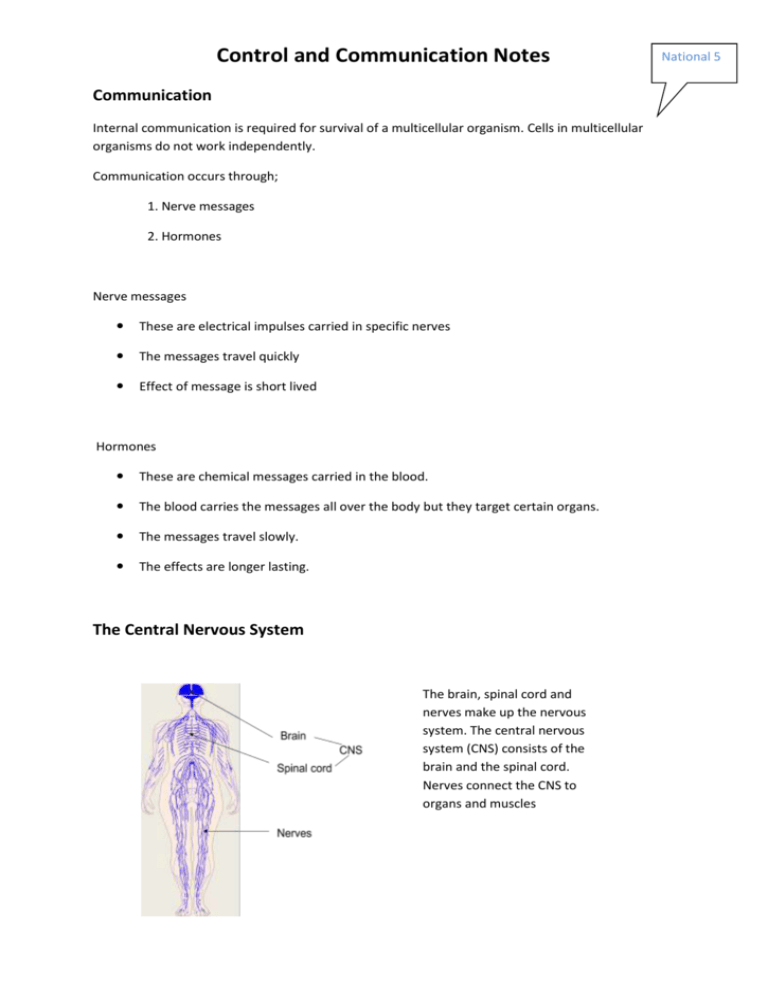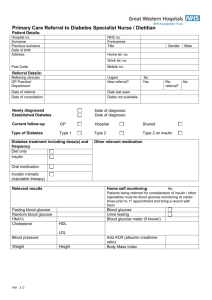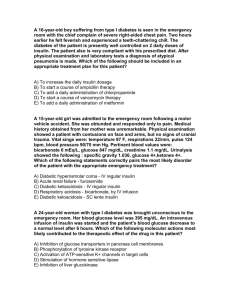Control and Communication
advertisement

Control and Communication Notes Communication Internal communication is required for survival of a multicellular organism. Cells in multicellular organisms do not work independently. Communication occurs through; 1. Nerve messages 2. Hormones Nerve messages These are electrical impulses carried in specific nerves The messages travel quickly Effect of message is short lived Hormones These are chemical messages carried in the blood. The blood carries the messages all over the body but they target certain organs. The messages travel slowly. The effects are longer lasting. The Central Nervous System The brain, spinal cord and nerves make up the nervous system. The central nervous system (CNS) consists of the brain and the spinal cord. Nerves connect the CNS to organs and muscles National 5 Control and Communication Notes Types of neurones There are 3 types of neurone (nerve cell). The Sensory nerve cell or NEURONE carries electrical impulses from the sensory organ to the CNS. The motor neurone travels from the CNS to a muscle or gland. The response may be a rapid action from a muscle or a slower response from a gland A relay neurone is only found within the CNS. It connects the sensory and motor neurones Control and Communication Notes Synapse – tiny gaps These are the gaps between neurons where chemicals are released to trigger an impulse in the next neuron. Route travelled by nerve impulses Electrical impulses travel to the CNS via the sensory neurone. The CNS processes information from our senses which needs a response. The information will pass to the relay neuron within the CNS. Impulses pass to the motor neurone which will carry them to the muscle or gland where action will be taken. Reflex Arc A reflex arc is needed for protection. E.g. blinking, withdrawal of hand from boiling water. It is simple response which you do not have to think about. Firstly the Central Nervous system sorts out the information sent by the senses. The Information is then sent to the correct muscles. The muscles make the appropriate response Control and Communication Notes The Brain Control and Communication Notes Endocrine System In animals, endocrine glands produce hormones (chemical messengers) and secrete them directly into the bloodstream. Hormones travel in the blood to so called ‘target tissues’ where they bring about a response. Target tissues have cells with receptors for hormones, so only some tissues are affected by specific hormones. The target cell has specific receptors and the hormone fits the receptor on the target cell only. Blood Glucose Regulation All living cells in the human body need a continuous supply of energy. This is gained through respiration. Glucose is required for respiration. Two hormones are involved in controlling blood glucose levels. 1. Insulin This is produced by the Pancreas. It is carried in the blood to the target organ - Liver. Insulin causes the liver to take up glucose from the blood and convert it to a storage carbohydrate called glycogen and therefore reduces the levels of glucose in the blood. Insulin Glucose Glycogen Control and Communication Notes 2. Glucagon This is produced by the Pancreas. It is carried in the blood to the target organ - Liver. Glucagon causes the liver to convert the storage carbohydrate glycogen to glucose and therefore increases the levels of glucose in the blood. Glucagon Glycogen Glucose Blood glucose levels in the body stay at a constant level. Varying levels of insulin and glycogen are produced depending on whether a person has just eaten or has used up lots of energy. Benefits include: There is always enough sugar (glucose) in the blood to be delivered to cells for respiration. There is not too much sugar in the blood, which would cause water to leave body cells by osmosis, causing the body cells to shrivel and cease to function. Diabetes Diabetes is a condition caused by a communication pathway failure which; Results in a fault in release of insulin or Results in a failure to respond to insulin The main symptoms of undiagnosed diabetes can include: passing urine more often than usual, especially at night increased thirst extreme tiredness unexplained weight loss slow healing of cuts and wounds blurred vision Control and Communication Notes Type 1 diabetes Type 1 diabetes usually develops early in life and is the most common type of diabetes in children. It occurs when the body is unable to produce any insulin. Type 1 diabetes is treated with insulin injections, or by using an insulin pump. Type 2 diabetes Type 2 diabetes is the most widespread form of the condition and usually develops later in life. This develops when the body is unable to make enough insulin, or when the insulin that is produced does not work properly (known as insulin resistance). Type 2 diabetes can be treated with diet and physical activity alone, or combining these with tablets which lower glucose levels in the blood. Due to the progressive nature of the condition, insulin treatment may be required later in life.







